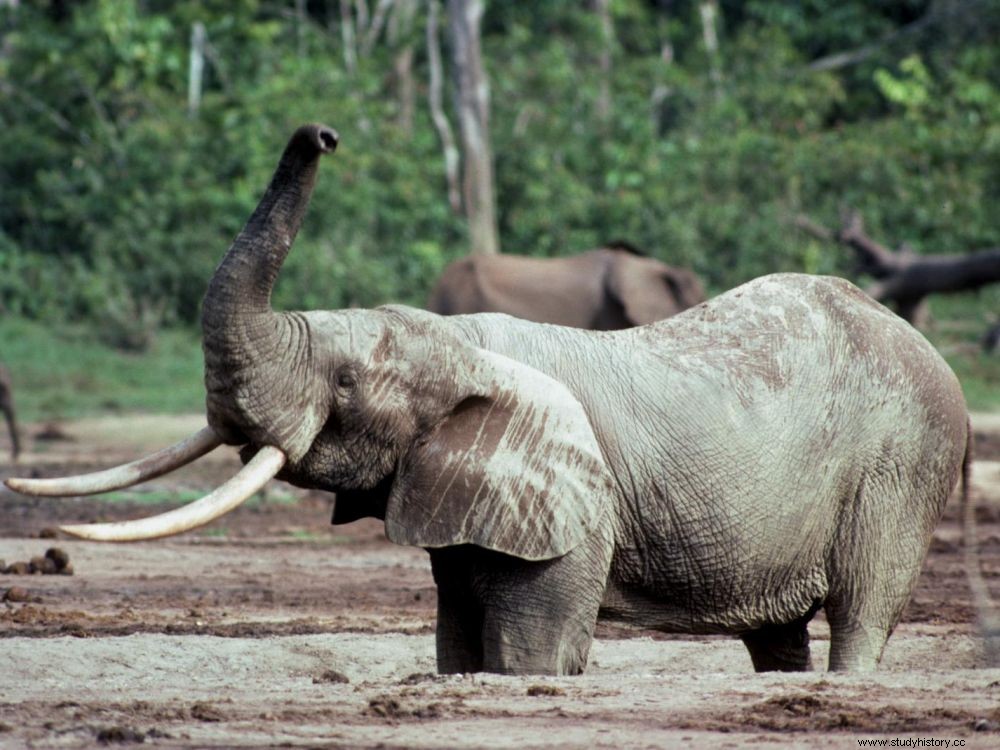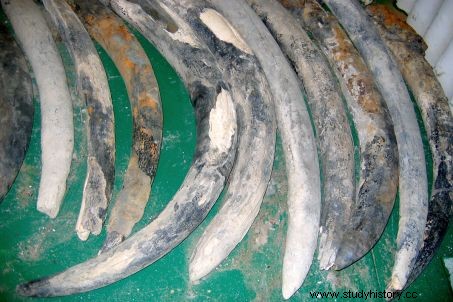This Portuguese ship sank in the 16th century with its cargo of gold and silver coins and elephant tusks whose origin has just been established.

An African forest elephant, Loxodonta cyclotis , of the same species as those whose tusks were found in the Bom Jesus .
In the 16th century, ivory was a central driver of the transcontinental trading system linking Europe, Africa and Asia via sea routes and many ships left African shores laden with valuable goods. Like the Bom Jesus , a Portuguese ship that was wrecked off the coast of Namibia in 1533. Her wreckage was found in 2008, she was carrying 40 tons of cargo including copper and lead ingots, gold coins, silver and a hundred elephant tusks. An international collaboration of scientists had access to the ivory pieces and were thus able to trace their origin.
Tusks protected by ingots
The tusks had been stored in a lower level of the Bom Jesus, just below the copper and lead ingots. When the ship, a carrack that had left Lisbon in March 1533, sank, these ingots compressed the ivory and protected the tusks from erosion and attack by marine microorganisms. Especially since in the area of the shipwreck circulates a very cold current which also contributed to their preservation. So much so that their analysis has made it possible to gather valuable information on the group of elephants from which they come. Indeed, the scientists were able to extract DNA from 44 tusks and analyze the carbon and nitrogen isotope contents for 97 of them. Their results are published in the journal Current biology .

Some of the recovered tusks. Credit:Courtesy National Museum of Namibia .
In the 16th century, ivory was a central driver of the transcontinental trading system linking Europe, Africa and Asia via sea routes and many ships left African shores laden with valuable goods. Like the Bom Jesus , a Portuguese ship that was wrecked off the coast of Namibia in 1533. Her wreckage was found in 2008, she was carrying 40 tons of cargo including copper and lead ingots, gold coins, silver and a hundred elephant tusks. An international collaboration of scientists had access to the ivory pieces and were thus able to trace their origin.
Tusks protected by ingots
The tusks had been stored in a lower level of the Bom Jesus, just below the copper and lead ingots. When the ship, a carrack that had left Lisbon in March 1533, sank, these ingots compressed the ivory and protected the tusks from erosion and attack by marine microorganisms. Especially since in the area of the shipwreck circulates a very cold current which also contributed to their preservation. So much so that their analysis has made it possible to gather valuable information on the group of elephants from which they come. Indeed, the scientists were able to extract DNA from 44 tusks and analyze the carbon and nitrogen isotope contents for 97 of them. Their results are published in the journal Current biology .

Some of the recovered tusks. Credit:Courtesy National Museum of Namibia .
The 44 tusks that yielded DNA all came from elephants living in West Africa, forest elephants of the species Loxodonta cyclotis, smaller than the other African elephant, Loxodonta africana . This surprised scientists who expected to also discover the genes of Central African elephants since the Portuguese traded goods with the communities established along the Congo River. However, they had also installed many commercial ports throughout the West African coastal zone.
Forest elephants
The good state of preservation of the tusks made it possible to push the analyzes further and to obtain mitochondrial DNA (mtDNA). This mtDNA is transmitted only by the mother and is used to draw up family trees and to trace kinship links. Scientists have thus identified 17 different halotypes, which correspond to as many family lineages, four of which are still persisting in Africa. The others have disappeared, probably because of the excessive hunting that took place over several centuries. The consequence is that West Africa has today lost more than 95% of its elephants. The scarcity of natural habitats has also greatly contributed to this. The isotopic analyzes also revealed some details about the way of life of its forest elephants. They were relatively mobile and sometimes lived in wooded areas and sometimes on less wooded savannahs, depending on the season and probably to find watering areas.
This study demonstrates the interest of looking into old ivory collections to better understand the evolution of elephants on the different continents as well as the way in which they were hunted over the centuries. "There is enormous potential for the analysis of historic ivory from other wrecks...or museums to understand the history of elephant populations, the skills and lifestyles of the people who hunted and traded ivory, as well as the many journeys of African ivory around the world “, concludes one of the authors of this work, Ashley Coutu of the University of Oxford, in a press release.
